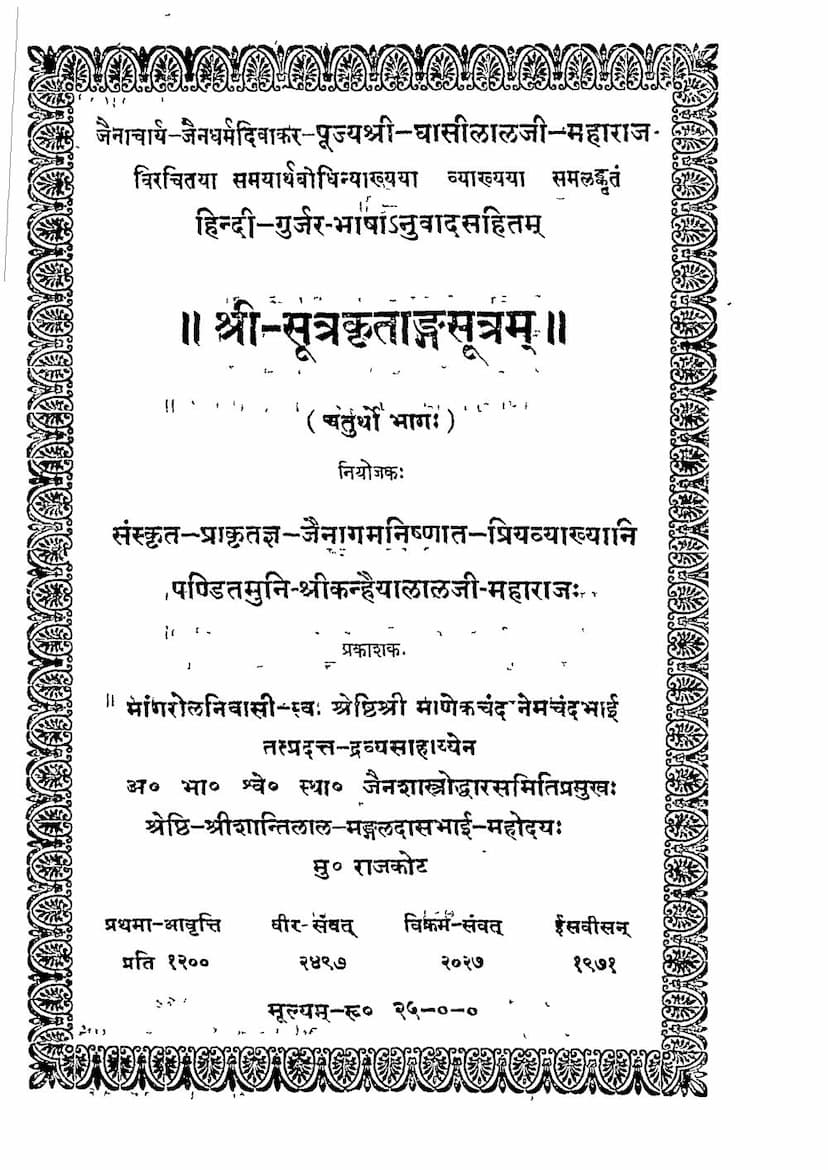Sutrakrutanga Sutram Part 04
Added to library: September 2, 2025

Summary
This Jain text, Sutrakrutanga Sutram Part 04, authored by Ghasilal Maharaj and published by A B Shwetambar Sthanakwasi Jain Shastroddhar Samiti, delves into the second Shruta Skandha of the Jain Agamas. The provided text summarizes the initial parts of this Skandha, focusing on the "Pundarika" and "Kriyasthan" chapters.
Overall Purpose:
The Sutrakrutanga Sutram, as a whole, aims to expound the Jain ethical and philosophical doctrines, particularly focusing on conduct, karma, and liberation. This particular volume, being the fourth part, continues this discourse, focusing on the complexities of action, its consequences, and the path to liberation.
Key Themes and Summarized Content:
The text, particularly the initial pages provided, serves as an introduction to the second Shruta Skandha, which is described as a more extensive and logically argued explanation of the concepts presented briefly in the first Shruta Skandha. The primary goal is to explain these concepts with the help of examples and reasoning for better understanding.
The second Shruta Skandha is presented as containing seven chapters:
-
Pundarika: This chapter, named after the lotus flower (Pundarika), uses the lotus as a metaphor to inspire devotion to Dharma. It narrates the stories of great individuals who were drawn to the spiritual path, turning away from worldly pleasures. The text begins with the first sutra of this chapter, "Suyam me ausalam tenam Bhagavatā ekam ākhyātam" (I have heard, O venerable one! That which the Blessed One has declared). It describes a beautiful lotus pond filled with lotuses of various kinds, with a magnificent lotus in the center, symbolizing the rarity and beauty of spiritual attainment and the lives of those who achieve it. The subsequent sutras introduce the first man who, despite his boasting and perceived knowledge, fails to reach the lotus in the pond due to his own limitations and pride. This is followed by the narratives of a second, third, and fourth man, each exhibiting similar overconfidence and failure, highlighting the inadequacy of mere knowledge without true understanding and practice. The fifth man, a Bhikshu, succeeds by approaching the problem with humility and understanding, symbolizing the Jain path. The text then begins to elaborate on the allegorical meaning of this story, connecting the pond, lotuses, and the men to different aspects of spiritual practice and human conditions.
-
Kriyasthan (Place of Action): This chapter, as indicated by its name and the introductory text, focuses on the concept of karma and kriya (action) in Jainism. It aims to explain how actions lead to bondage and how understanding the "twelve Kriyasthan" (places of action) can help in liberation. The text mentions that a wise person seeking liberation must first understand these twelve Kriyasthan. The ultimate goal of understanding these actions is to break free from the cycle of birth and death. The provided excerpt begins to introduce the concept of actions (kriya) and their impact, suggesting a detailed breakdown of various types of actions, their ethical implications, and their role in the karmic cycle. The text seems to be moving towards explaining actions that lead to bondage and those that lead to liberation.
Key Concepts Introduced:
- Karma and Action: The text emphasizes the understanding of actions and their consequences, a central tenet of Jainism. The concept of kriya (action) is highlighted as crucial for understanding bondage and liberation.
- Allegory and Example: The use of stories and metaphors, like the lotus pond in the Pundarika chapter, is employed to illustrate profound spiritual truths in a relatable manner.
- The Path to Liberation: The narratives and explanations are geared towards guiding the aspirant towards liberation (moksha) by understanding the nature of bondage and the means to overcome it.
- Ethical Conduct: The chapters implicitly or explicitly guide the reader towards righteous conduct, distinguishing between actions that lead to spiritual progress and those that lead to further entanglement in the cycle of birth and death.
Overall, the excerpt provides a foundational understanding of the second Shruta Skandha, setting the stage for a detailed exploration of Jain philosophy, ethics, and the path to spiritual freedom through the analysis of various actions and their karmic implications.